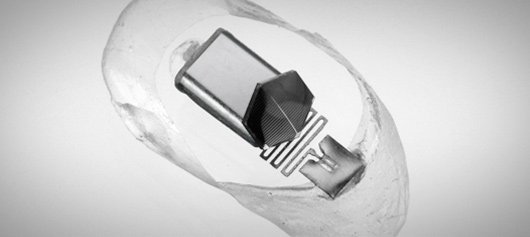The U.S. Food and Drug Administration has allowed the marketing of a new hearing aid that uses a laser diode and direct vibration of the eardrum to amplify sound. This device is for use by adults with mild to severe sensorineural hearing impairment.
With the the EarLens Contact Hearing Device (CHD), the combination of laser light pulses and a custom-fit device component that comes in direct contact with the eardrum is designed to use the patient’s own eardrum as a speaker and enables amplification over a wider range of frequencies for some hearing impaired persons.

The EarLens Contact Hearing Device (CHD) is indicated for use by adults with mild to severe sensorineural hearing impairment.
According to statistics compiled by the National Institute on Deafness and Other Communication Disorders, 37.5 million adults aged 18 and older in America report some form of hearing loss. However, only 30 percent of adults aged 70 and older and 16 percent of adults aged 20 to 69 who could benefit from wearing hearing aids have ever used them.
“For the millions of Americans with hearing impairment, hearing aids can significantly improve regular daily communications, as well as overall quality of life,” said William Maisel, M.D., M.P.H., deputy director for science and chief scientist in the FDA’s Center for Devices and Radiological Health. “People with hearing impairment now have a new option that may help improve their hearing by amplifying sounds over a broad spectrum of frequencies.”
Continue Reading Below ↓↓↓
The EarLens CHD consists of two parts: a tympanic membrane transducer (TMT), which is non-surgically placed deeply into the ear canal on the eardrum, and a behind-the-ear (BTE) audio processor that sits on the outer ear and is connected to an ear tip that is placed in the ear canal. External sound waves received by the BTE processor are converted to electronic signals, digitally processed, amplified and sent to the ear tip, which contains a laser diode. There, the electronic signals of amplified sound are converted to pulses of light. The laser light pulses then shine onto a photodetector in the TMT, which converts the light back into electronic signals, transmitting sound vibrations directly to the eardrum by direct contact.
The EarLens CHD differs from traditional air conduction hearing aids in several ways. The TMT component is custom-molded to the patient’s eardrum and contains a driver mechanism that directly stimulates the eardrum, enabling efficient amplification of sound (functional gain).
Clinical data supporting the safety and effectiveness of the EarLens CHD included several assessments over a four-month period, such as residual hearing stability, improved word recognition, functional amplification gain and the ability to hear sentences in background noise compared to listening without any amplification. Studies showed that after 30 days of device use, the 48 subjects experienced, on average, a 33 percent improvement in word recognition. Users also experienced a clinically significant functional gain of 30.5 decibels (dB) on average in the high frequency range (2,000-10,000 Hz), with an average of 30-40 dB of functional gain noted at 6,000 Hz and above and a maximum of 68 dB at 9,000-10,000 Hz, which is not typically achieved with conventional air-conduction hearing aids.
Several subjects experienced abrasions in the ear canal, primarily related to ear tip use or the impression-making procedure. There were no serious device-related adverse events.
The FDA reviewed the data for the EarLens CHD through the de novo premarket review pathway, a regulatory pathway for some low- to moderate-risk medical devices that are not substantially equivalent to an already legally-marketed device.
EarLens CHD is manufactured by EarLens Corporation of Menlo Park, California.
Sources:FDA; EarLens Corporation




